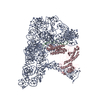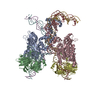[English] 日本語
 Yorodumi
Yorodumi- PDB-7d1a: cryo-EM structure of a group II intron RNP complexed with its rev... -
+ Open data
Open data
- Basic information
Basic information
| Entry | Database: PDB / ID: 7d1a | |||||||||
|---|---|---|---|---|---|---|---|---|---|---|
| Title | cryo-EM structure of a group II intron RNP complexed with its reverse transcriptase | |||||||||
 Components Components |
| |||||||||
 Keywords Keywords | TRANSFERASE/RNA /  catalytic RNA / RNA-protein interactions / TRANSFERASE-RNA complex catalytic RNA / RNA-protein interactions / TRANSFERASE-RNA complex | |||||||||
| Function / homology |  Function and homology information Function and homology informationintron homing /  mRNA processing / mRNA processing /  RNA-directed DNA polymerase / RNA-directed DNA polymerase /  RNA-directed DNA polymerase activity / RNA-directed DNA polymerase activity /  endonuclease activity / endonuclease activity /  Hydrolases; Acting on ester bonds Hydrolases; Acting on ester bondsSimilarity search - Function | |||||||||
| Biological species |   Lactococcus lactis subsp. cremoris (lactic acid bacteria) Lactococcus lactis subsp. cremoris (lactic acid bacteria) | |||||||||
| Method |  ELECTRON MICROSCOPY / ELECTRON MICROSCOPY /  single particle reconstruction / single particle reconstruction /  cryo EM / Resolution: 3.8 Å cryo EM / Resolution: 3.8 Å | |||||||||
 Authors Authors | Liu, N. / Dong, X.L. / Hu, C.X. / Zeng, J.W. / Wang, J.W. / Wang, J. / Wang, H.W. / Belfort, M. | |||||||||
| Funding support |  China, China,  United States, 2items United States, 2items
| |||||||||
 Citation Citation |  Journal: Nucleic Acids Res / Year: 2020 Journal: Nucleic Acids Res / Year: 2020Title: Exon and protein positioning in a pre-catalytic group II intron RNP primed for splicing. Authors: Nan Liu / Xiaolong Dong / Cuixia Hu / Jianwei Zeng / Jiawei Wang / Jia Wang / Hong-Wei Wang / Marlene Belfort /   Abstract: Group II introns are the putative progenitors of nuclear spliceosomal introns and use the same two-step splicing pathway. In the cell, the intron RNA forms a ribonucleoprotein (RNP) complex with the ...Group II introns are the putative progenitors of nuclear spliceosomal introns and use the same two-step splicing pathway. In the cell, the intron RNA forms a ribonucleoprotein (RNP) complex with the intron-encoded protein (IEP), which is essential for splicing. Although structures of spliced group II intron RNAs and RNP complexes have been characterized, structural insights into the splicing process remain enigmatic due to lack of pre-catalytic structural models. Here, we report two cryo-EM structures of endogenously produced group II intron RNPs trapped in their pre-catalytic state. Comparison of the catalytically activated precursor RNP to its previously reported spliced counterpart allowed identification of key structural rearrangements accompanying splicing, including a remodeled active site and engagement of the exons. Importantly, altered RNA-protein interactions were observed upon splicing among the RNP complexes. Furthermore, analysis of the catalytically inert precursor RNP demonstrated the structural impact of the formation of the active site on RNP architecture. Taken together, our results not only fill a gap in understanding the structural basis of IEP-assisted group II intron splicing, but also provide parallels to evolutionarily related spliceosomal splicing. | |||||||||
| History |
|
- Structure visualization
Structure visualization
| Movie |
 Movie viewer Movie viewer |
|---|---|
| Structure viewer | Molecule:  Molmil Molmil Jmol/JSmol Jmol/JSmol |
- Downloads & links
Downloads & links
- Download
Download
| PDBx/mmCIF format |  7d1a.cif.gz 7d1a.cif.gz | 423.1 KB | Display |  PDBx/mmCIF format PDBx/mmCIF format |
|---|---|---|---|---|
| PDB format |  pdb7d1a.ent.gz pdb7d1a.ent.gz | 325.5 KB | Display |  PDB format PDB format |
| PDBx/mmJSON format |  7d1a.json.gz 7d1a.json.gz | Tree view |  PDBx/mmJSON format PDBx/mmJSON format | |
| Others |  Other downloads Other downloads |
-Validation report
| Arichive directory |  https://data.pdbj.org/pub/pdb/validation_reports/d1/7d1a https://data.pdbj.org/pub/pdb/validation_reports/d1/7d1a ftp://data.pdbj.org/pub/pdb/validation_reports/d1/7d1a ftp://data.pdbj.org/pub/pdb/validation_reports/d1/7d1a | HTTPS FTP |
|---|
-Related structure data
| Related structure data |  3331M  7d0fC  7d0gC M: map data used to model this data C: citing same article ( |
|---|---|
| Similar structure data |
- Links
Links
- Assembly
Assembly
| Deposited unit | 
|
|---|---|
| 1 |
|
- Components
Components
| #1: Protein | Mass: 70286.664 Da / Num. of mol.: 1 Source method: isolated from a genetically manipulated source Source: (gene. exp.)   Lactococcus lactis subsp. cremoris (lactic acid bacteria) Lactococcus lactis subsp. cremoris (lactic acid bacteria)Gene: ltrA, matR Production host:   Lactococcus lactis subsp. cremoris (lactic acid bacteria) Lactococcus lactis subsp. cremoris (lactic acid bacteria)Strain (production host): IL1403 References: UniProt: P0A3U0,  RNA-directed DNA polymerase, RNA-directed DNA polymerase,  Hydrolases; Acting on ester bonds Hydrolases; Acting on ester bonds |
|---|---|
| #2: RNA chain | Mass: 291363.969 Da / Num. of mol.: 1 Source method: isolated from a genetically manipulated source Source: (gene. exp.)   Lactococcus lactis subsp. cremoris (lactic acid bacteria) Lactococcus lactis subsp. cremoris (lactic acid bacteria)Production host:   Lactococcus lactis subsp. cremoris (lactic acid bacteria) Lactococcus lactis subsp. cremoris (lactic acid bacteria)Strain (production host): IL1403 |
| #3: RNA chain | Mass: 4068.518 Da / Num. of mol.: 1 Source method: isolated from a genetically manipulated source Source: (gene. exp.)   Lactococcus lactis subsp. cremoris (lactic acid bacteria) Lactococcus lactis subsp. cremoris (lactic acid bacteria)Production host:   Lactococcus lactis subsp. cremoris (lactic acid bacteria) Lactococcus lactis subsp. cremoris (lactic acid bacteria)Strain (production host): IL1403 |
-Experimental details
-Experiment
| Experiment | Method:  ELECTRON MICROSCOPY ELECTRON MICROSCOPY |
|---|---|
| EM experiment | Aggregation state: PARTICLE / 3D reconstruction method:  single particle reconstruction single particle reconstruction |
- Sample preparation
Sample preparation
| Component | Name: cryo-EM structure of a group II intron RNP complexed with its reverse transcriptase Type: COMPLEX / Entity ID: all / Source: RECOMBINANT |
|---|---|
| Source (natural) | Organism:   Lactococcus lactis subsp. cremoris (lactic acid bacteria) Lactococcus lactis subsp. cremoris (lactic acid bacteria) |
| Source (recombinant) | Organism:   Lactococcus lactis subsp. cremoris (lactic acid bacteria) Lactococcus lactis subsp. cremoris (lactic acid bacteria)Strain: IL1403 |
| Buffer solution | pH: 8 |
| Specimen | Embedding applied: NO / Shadowing applied: NO / Staining applied : NO / Vitrification applied : NO / Vitrification applied : YES : YES |
Vitrification | Cryogen name: ETHANE |
- Electron microscopy imaging
Electron microscopy imaging
| Experimental equipment |  Model: Titan Krios / Image courtesy: FEI Company | ||||||||||||||||
|---|---|---|---|---|---|---|---|---|---|---|---|---|---|---|---|---|---|
| Microscopy | Model: FEI TITAN KRIOS | ||||||||||||||||
| Electron gun | Electron source : :  FIELD EMISSION GUN / Accelerating voltage: 300 kV / Illumination mode: FLOOD BEAM FIELD EMISSION GUN / Accelerating voltage: 300 kV / Illumination mode: FLOOD BEAM | ||||||||||||||||
| Electron lens | Mode: BRIGHT FIELD Bright-field microscopy Bright-field microscopy | ||||||||||||||||
| Image recording |
|
- Processing
Processing
| Software | Name: PHENIX / Version: 1.16_3549: / Classification: refinement | ||||||||||||||||||||||||
|---|---|---|---|---|---|---|---|---|---|---|---|---|---|---|---|---|---|---|---|---|---|---|---|---|---|
CTF correction | Type: NONE | ||||||||||||||||||||||||
3D reconstruction | Resolution: 3.8 Å / Resolution method: FSC 0.143 CUT-OFF / Num. of particles: 450296 / Symmetry type: POINT | ||||||||||||||||||||||||
| Refine LS restraints |
|
 Movie
Movie Controller
Controller











 PDBj
PDBj





























